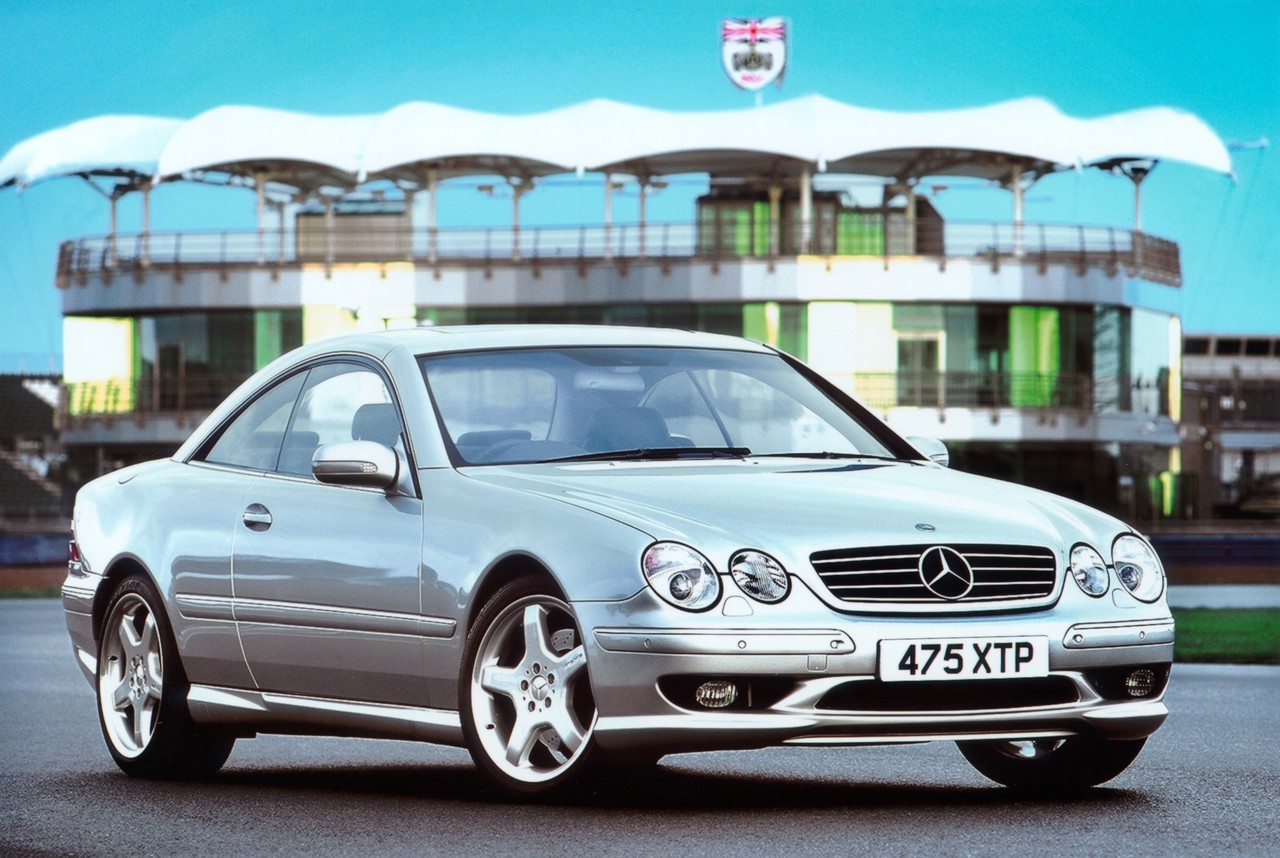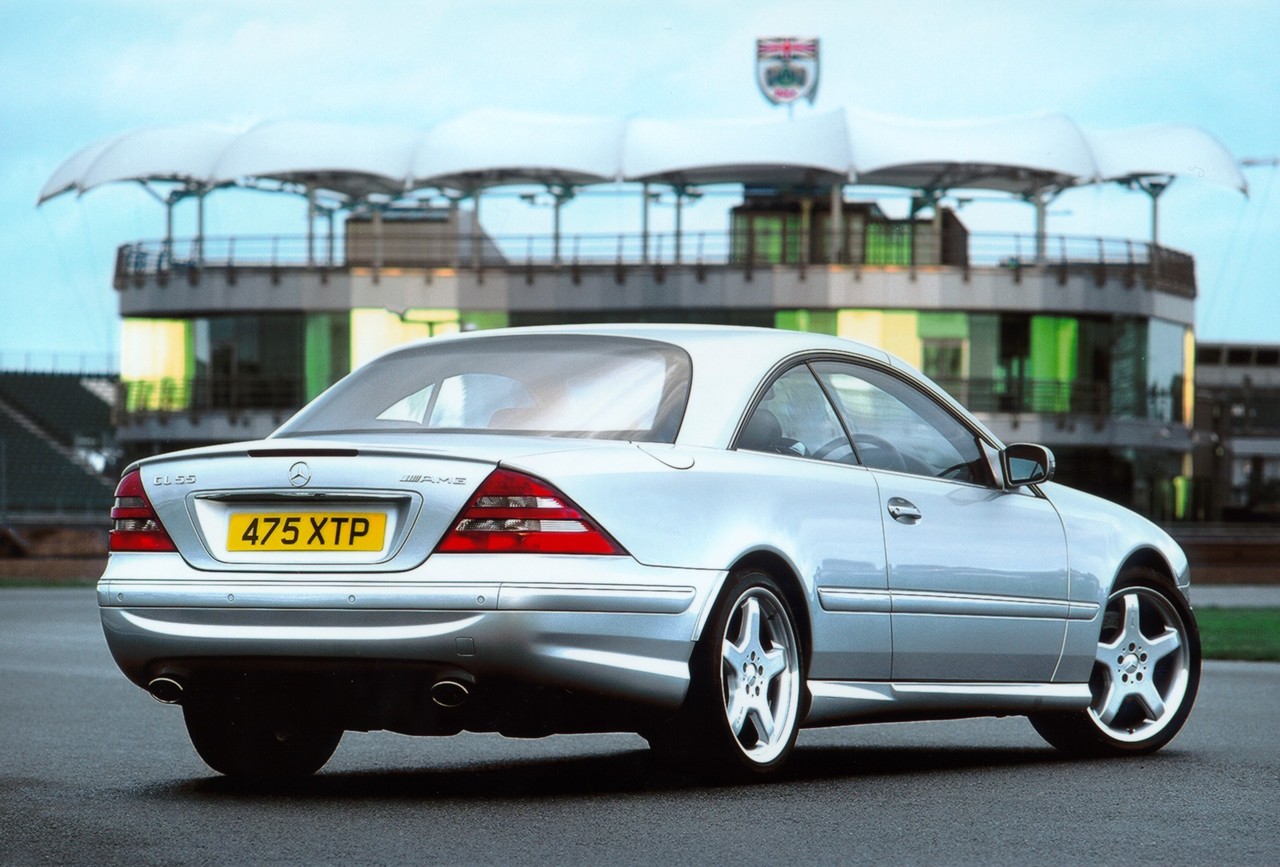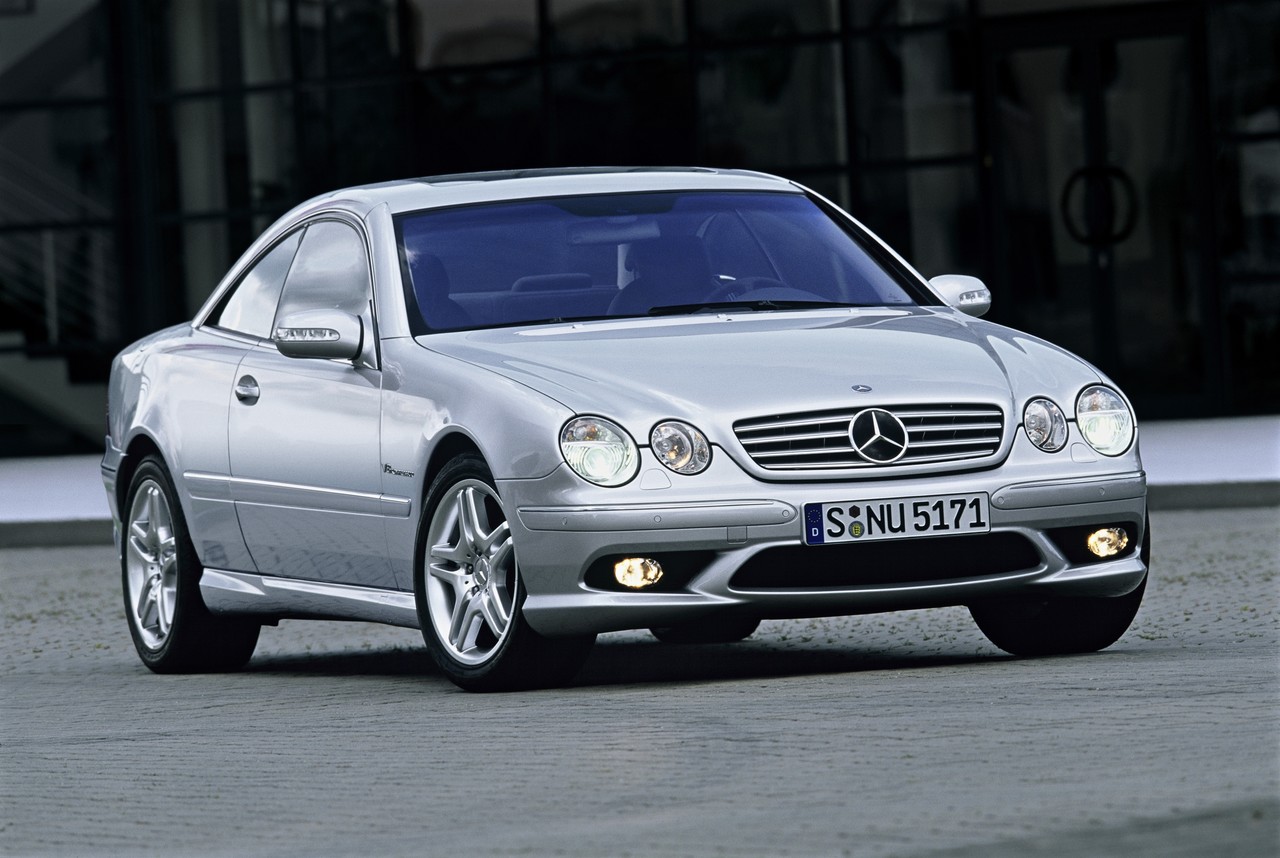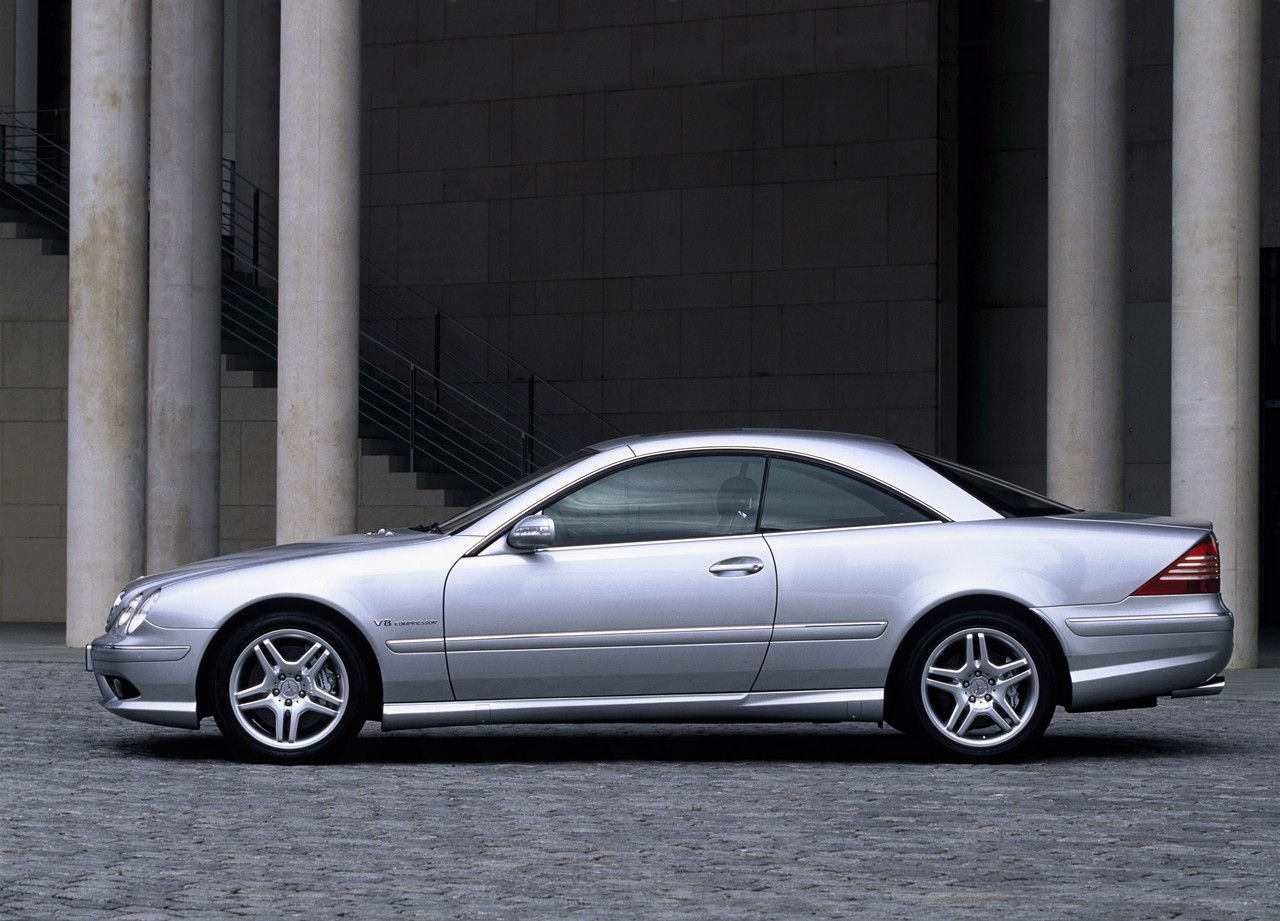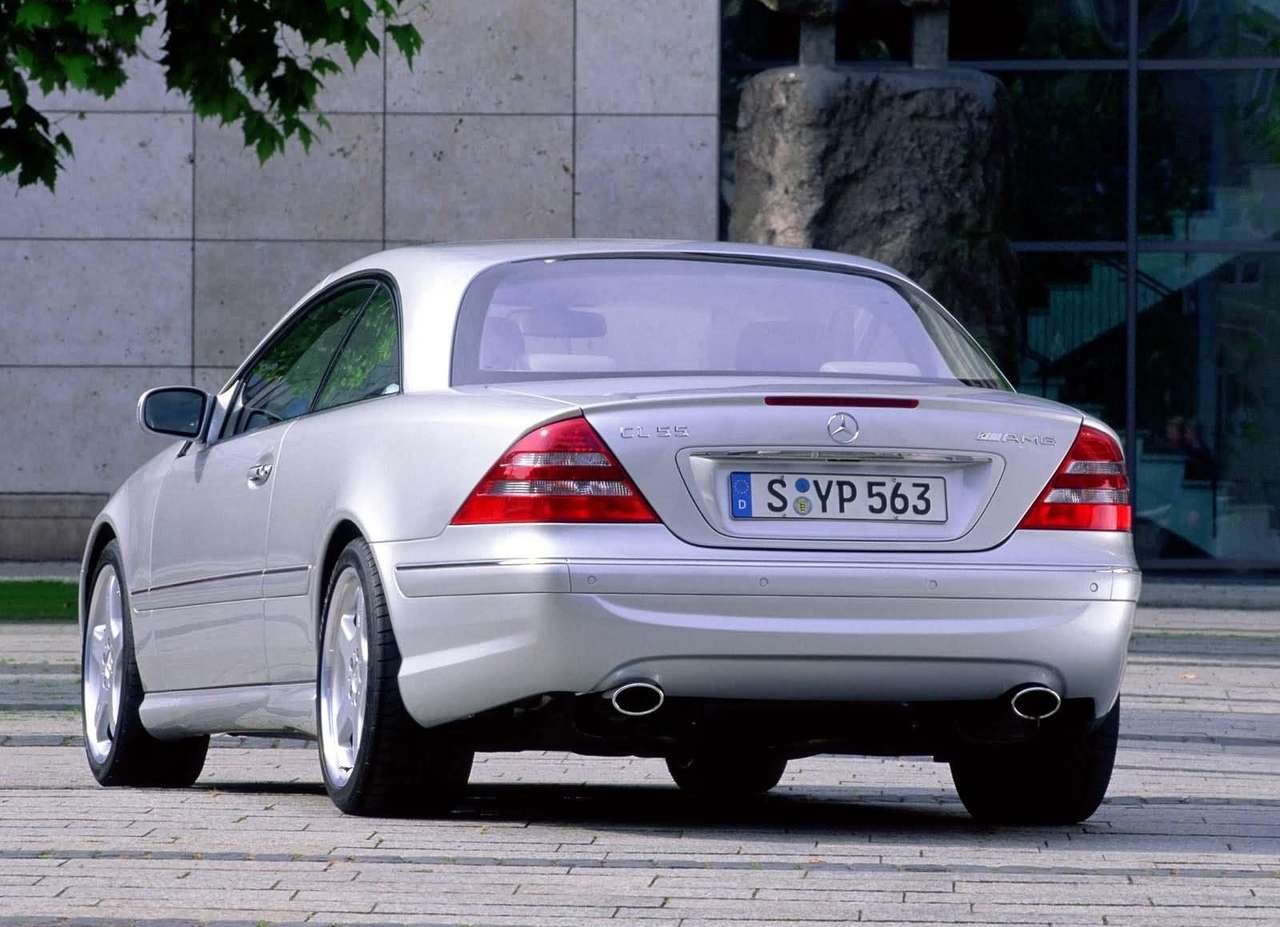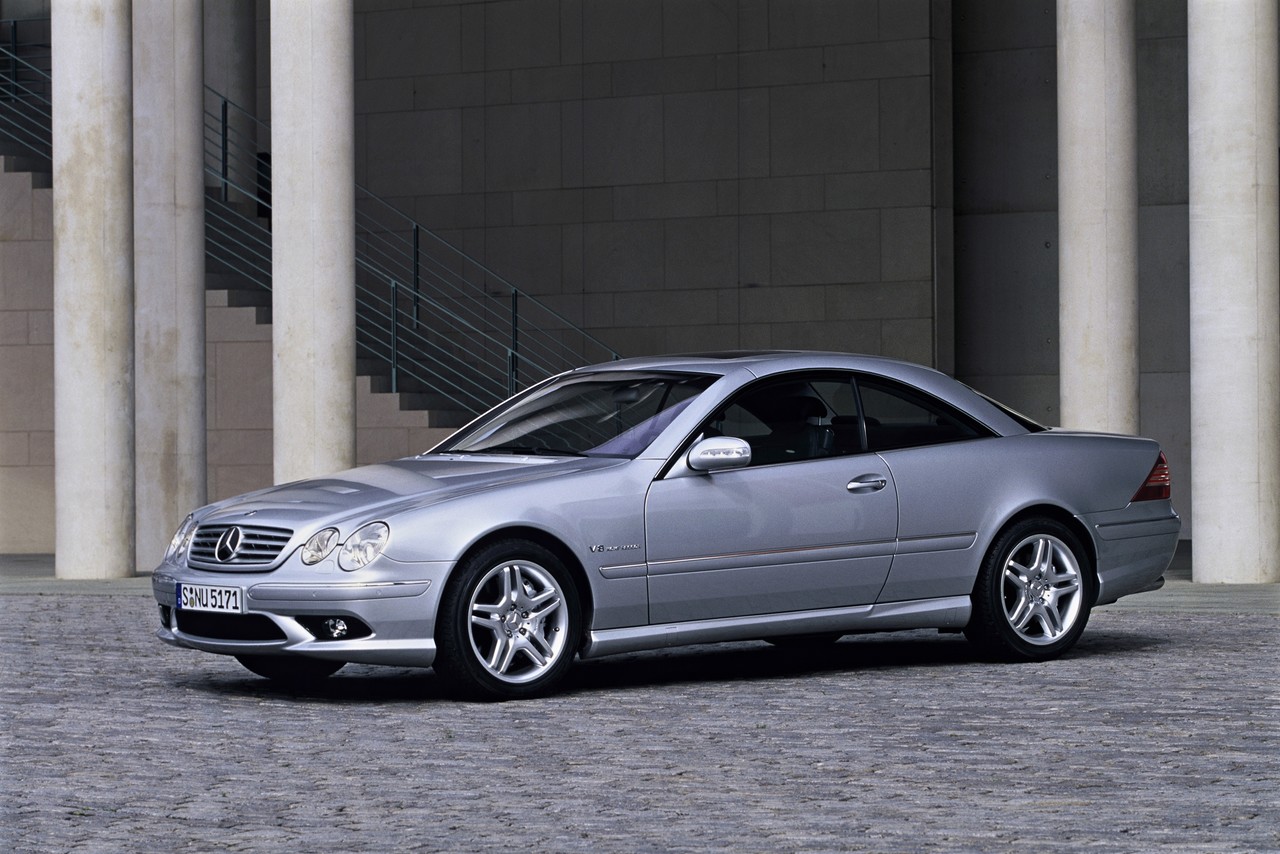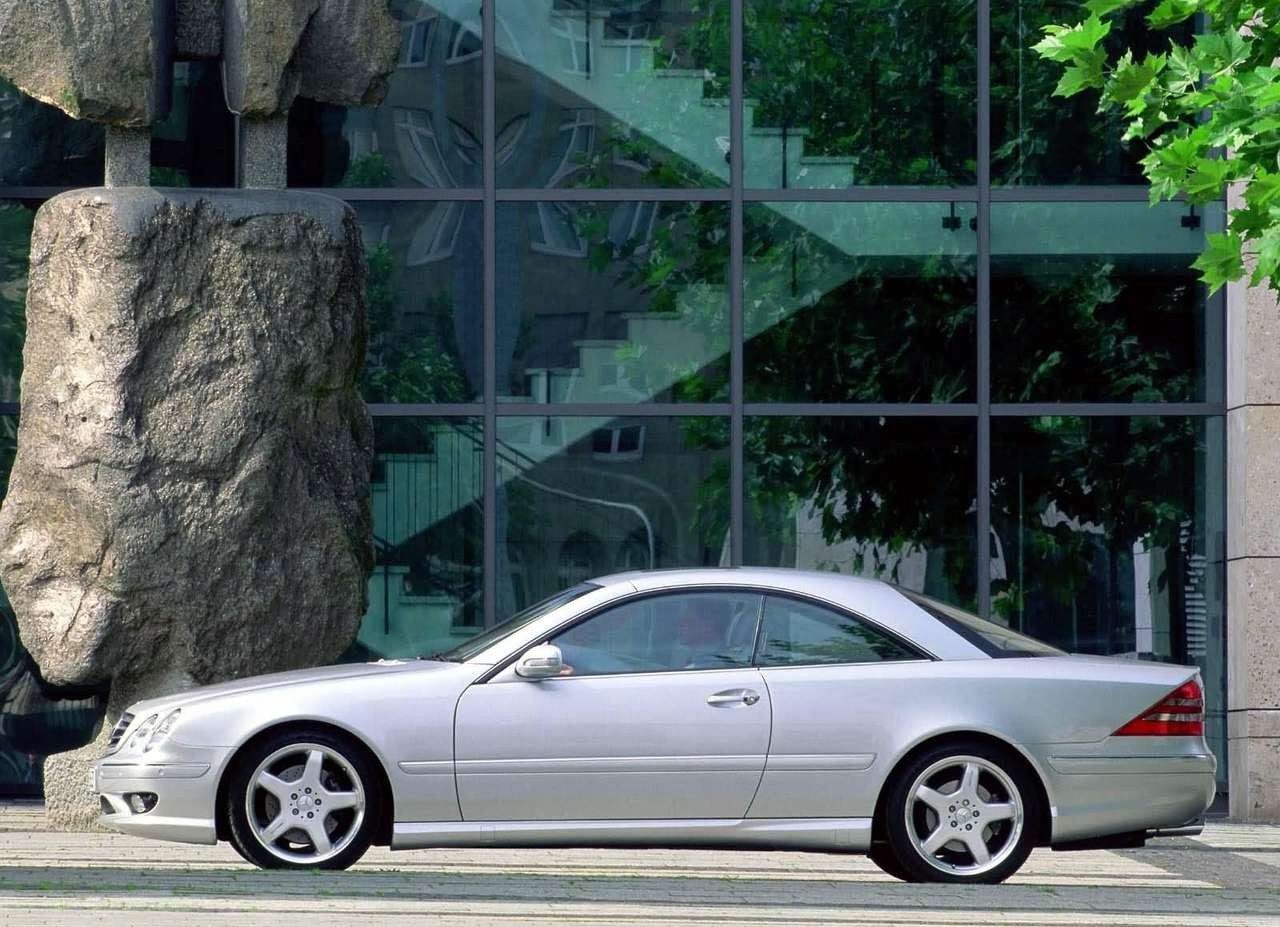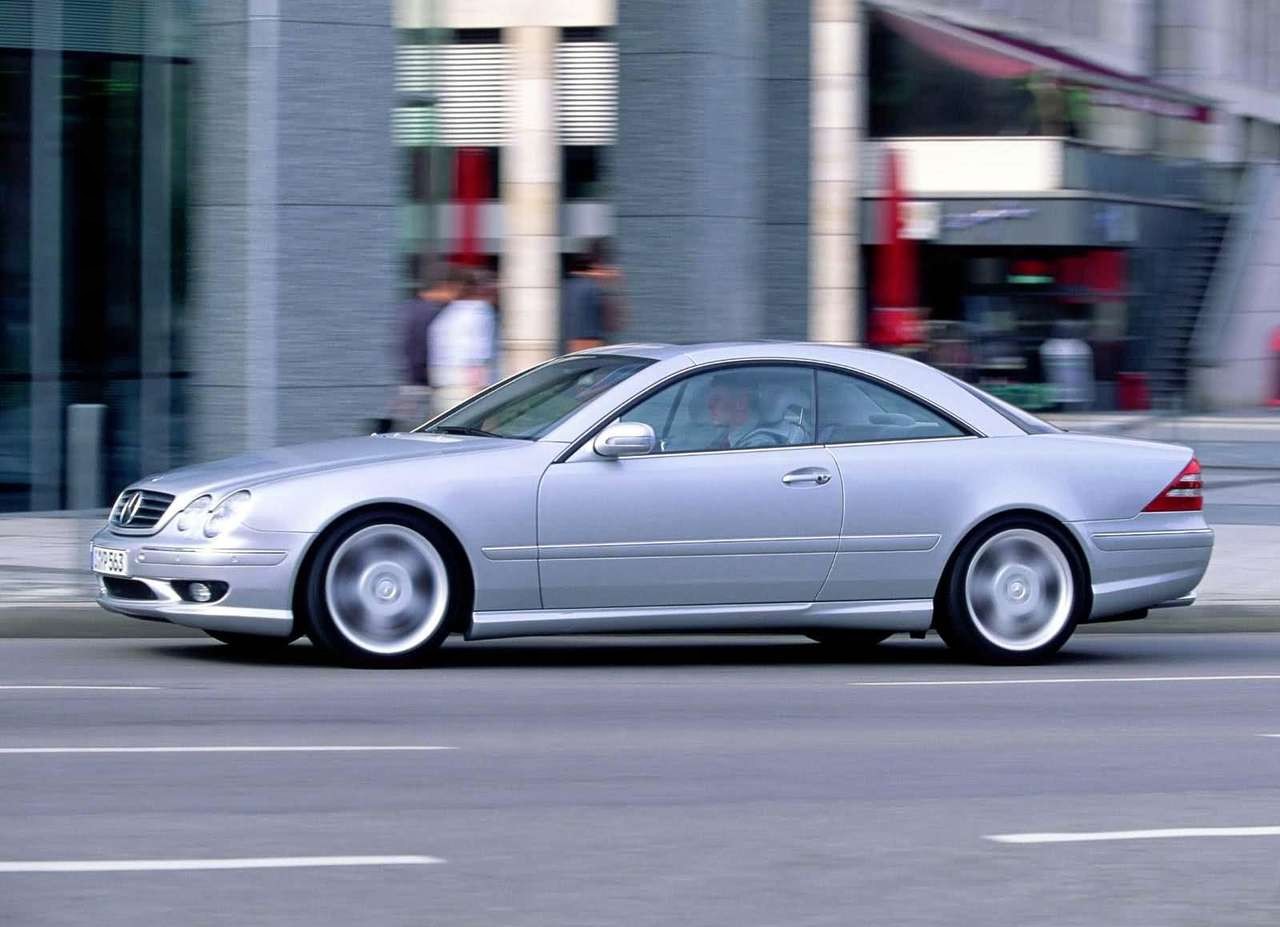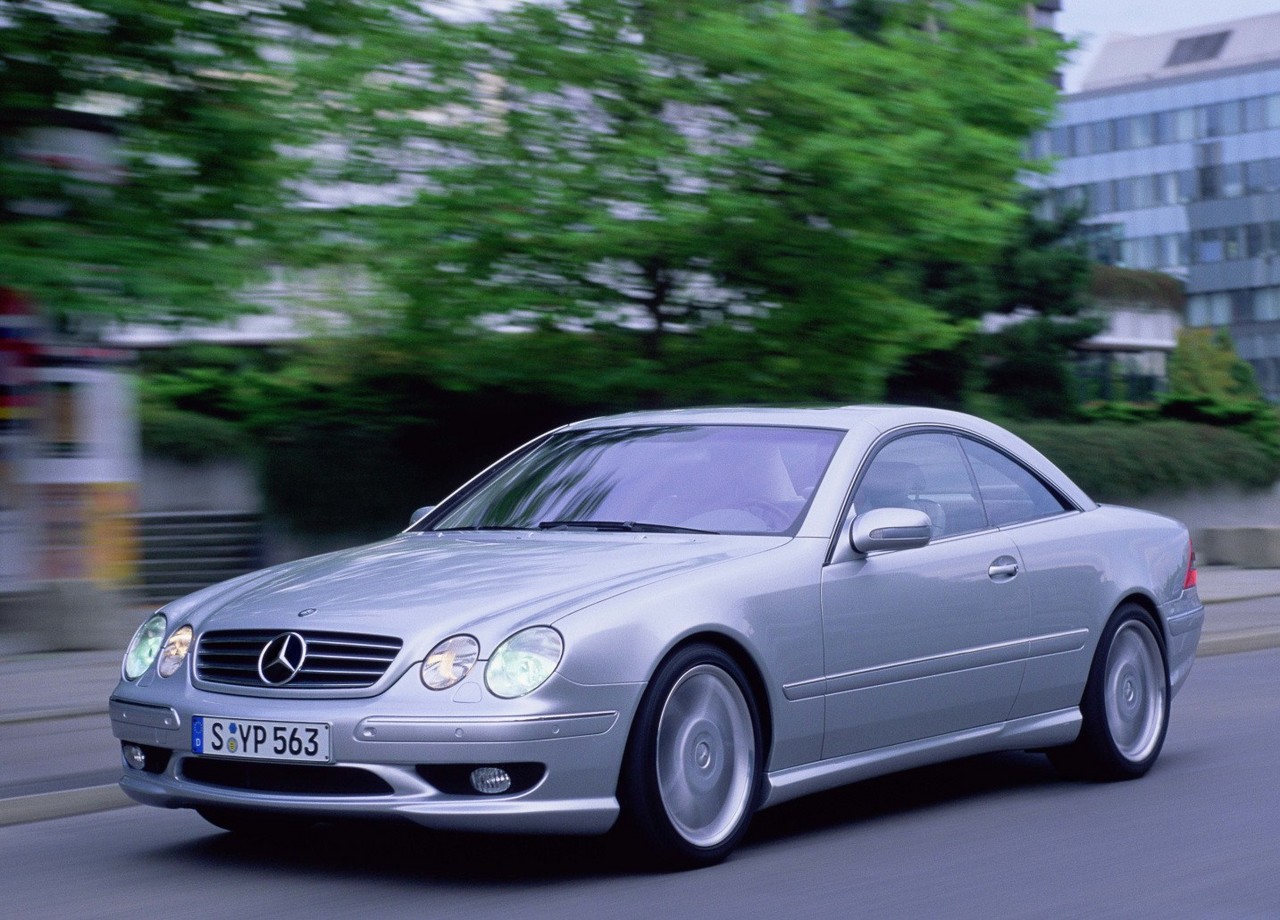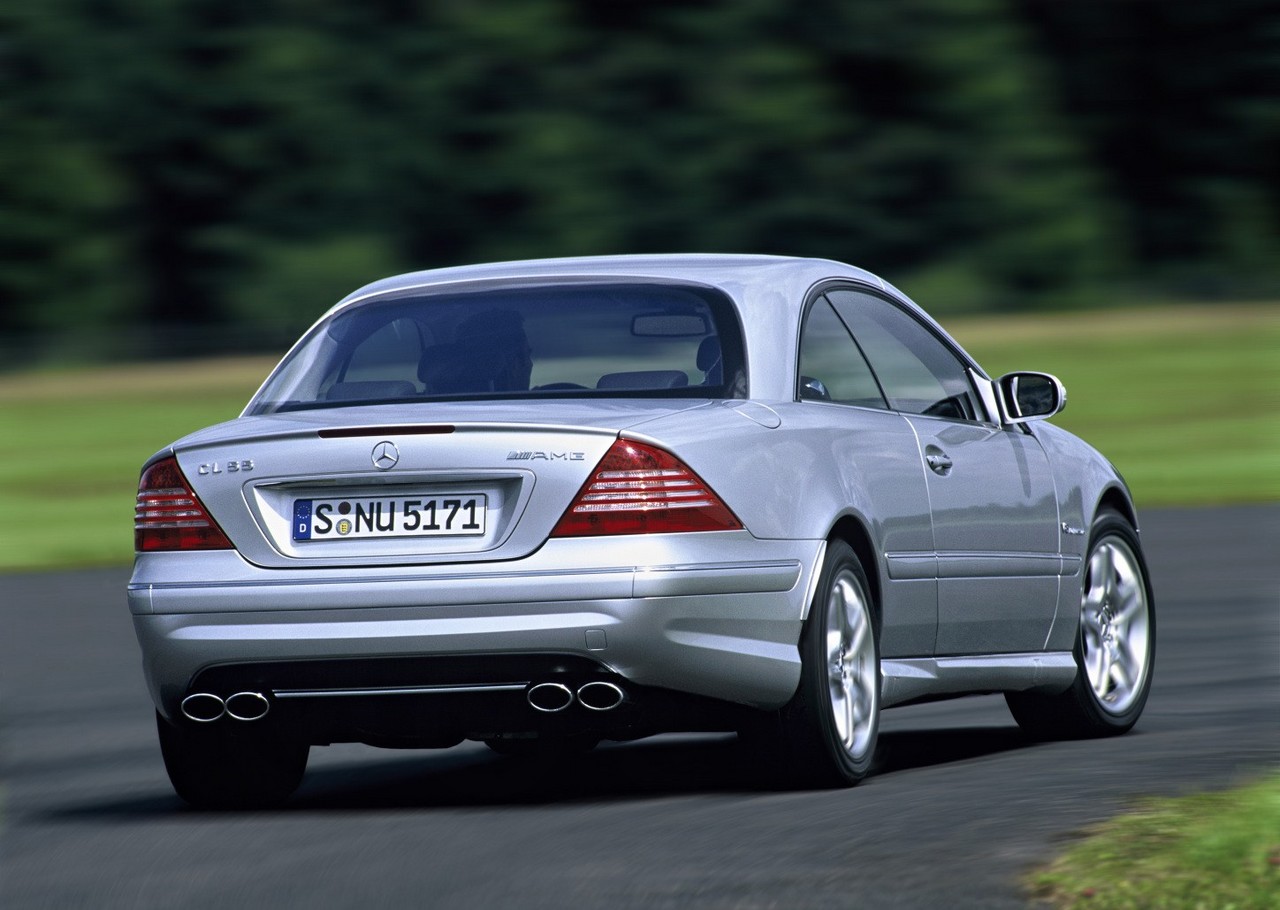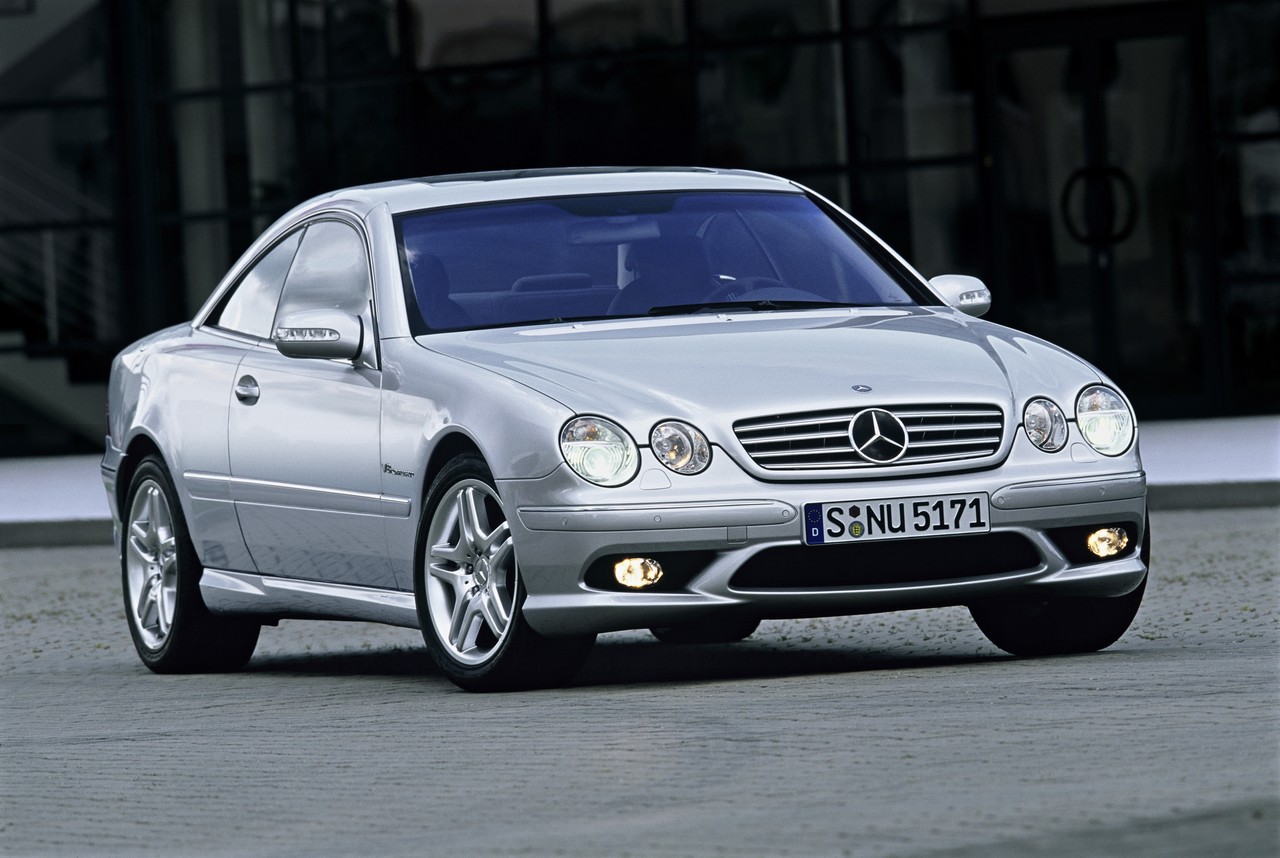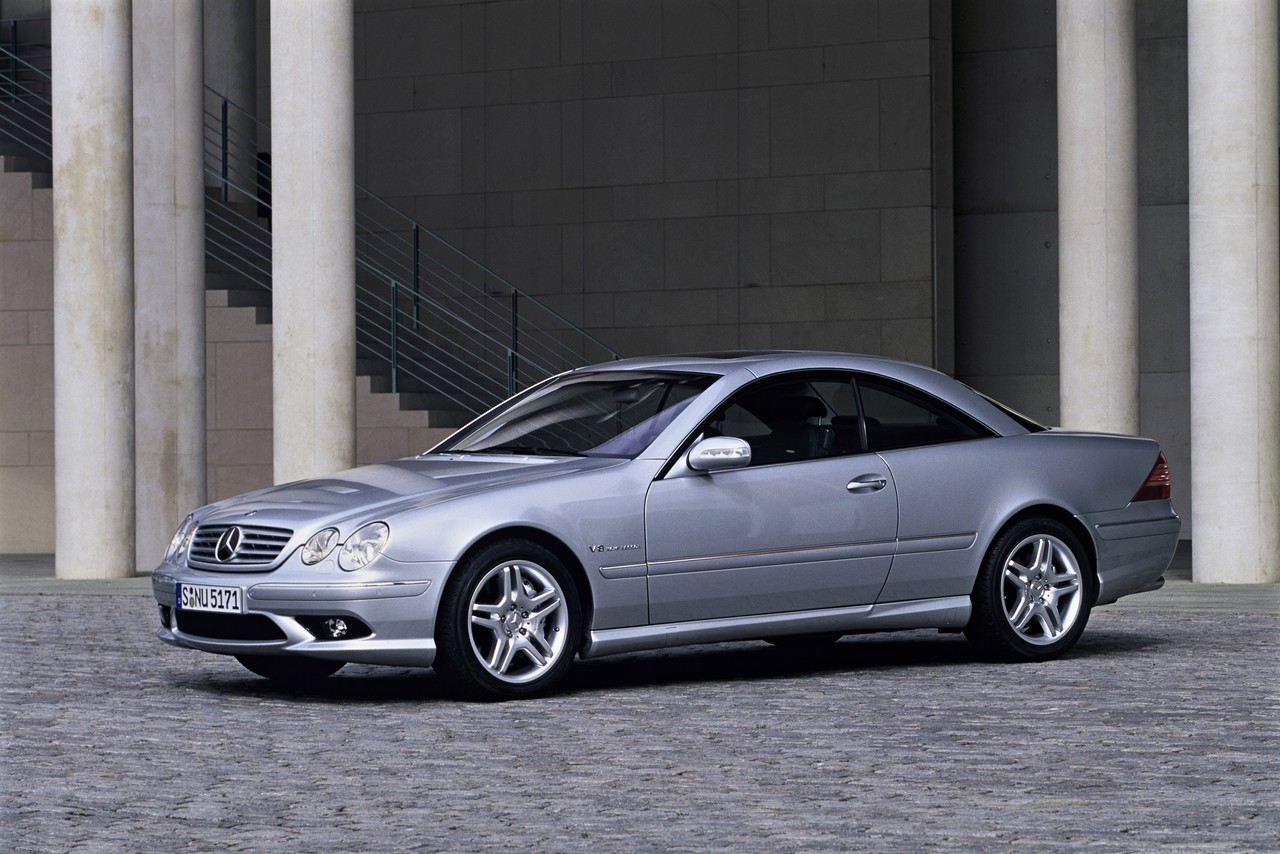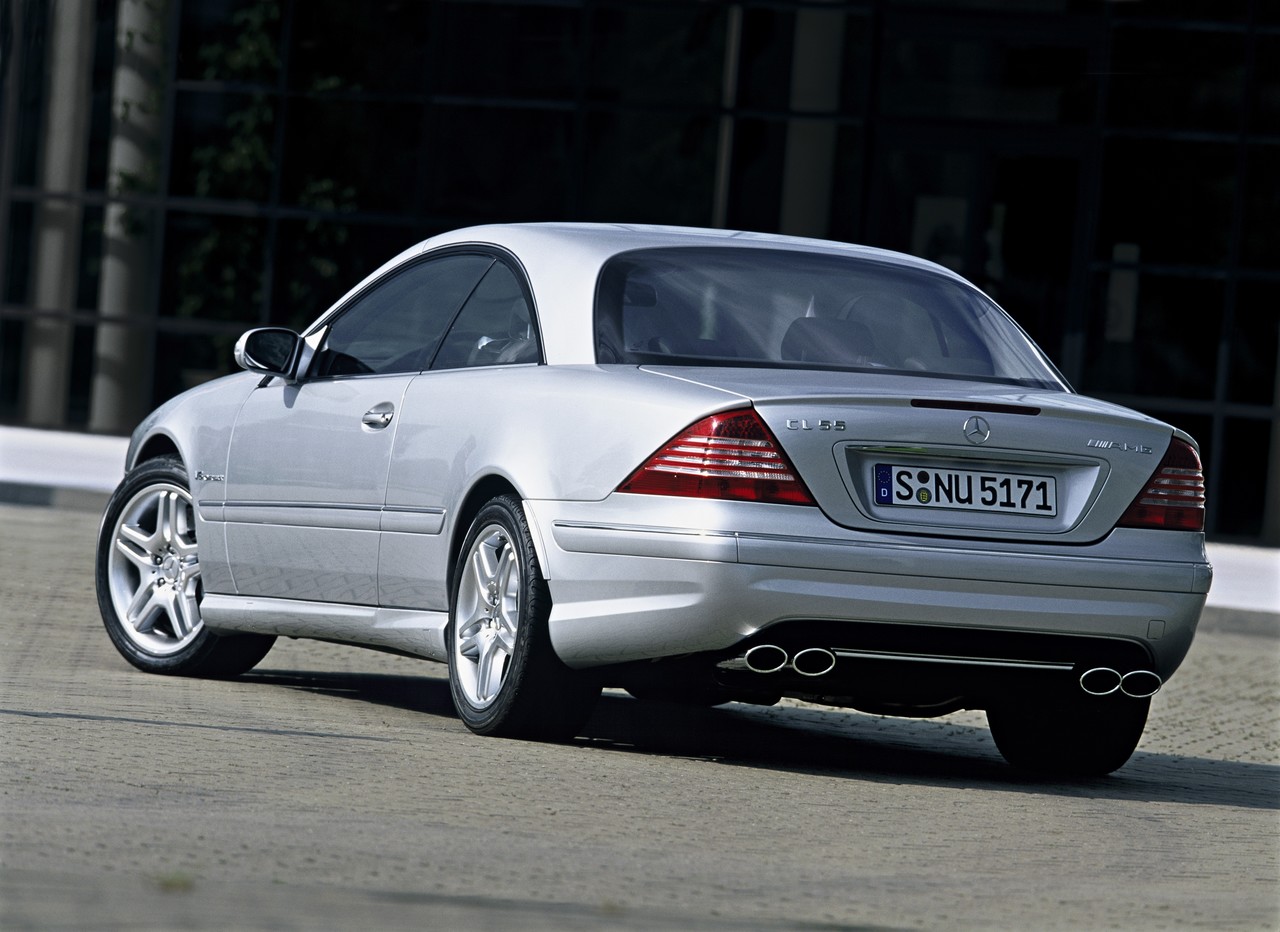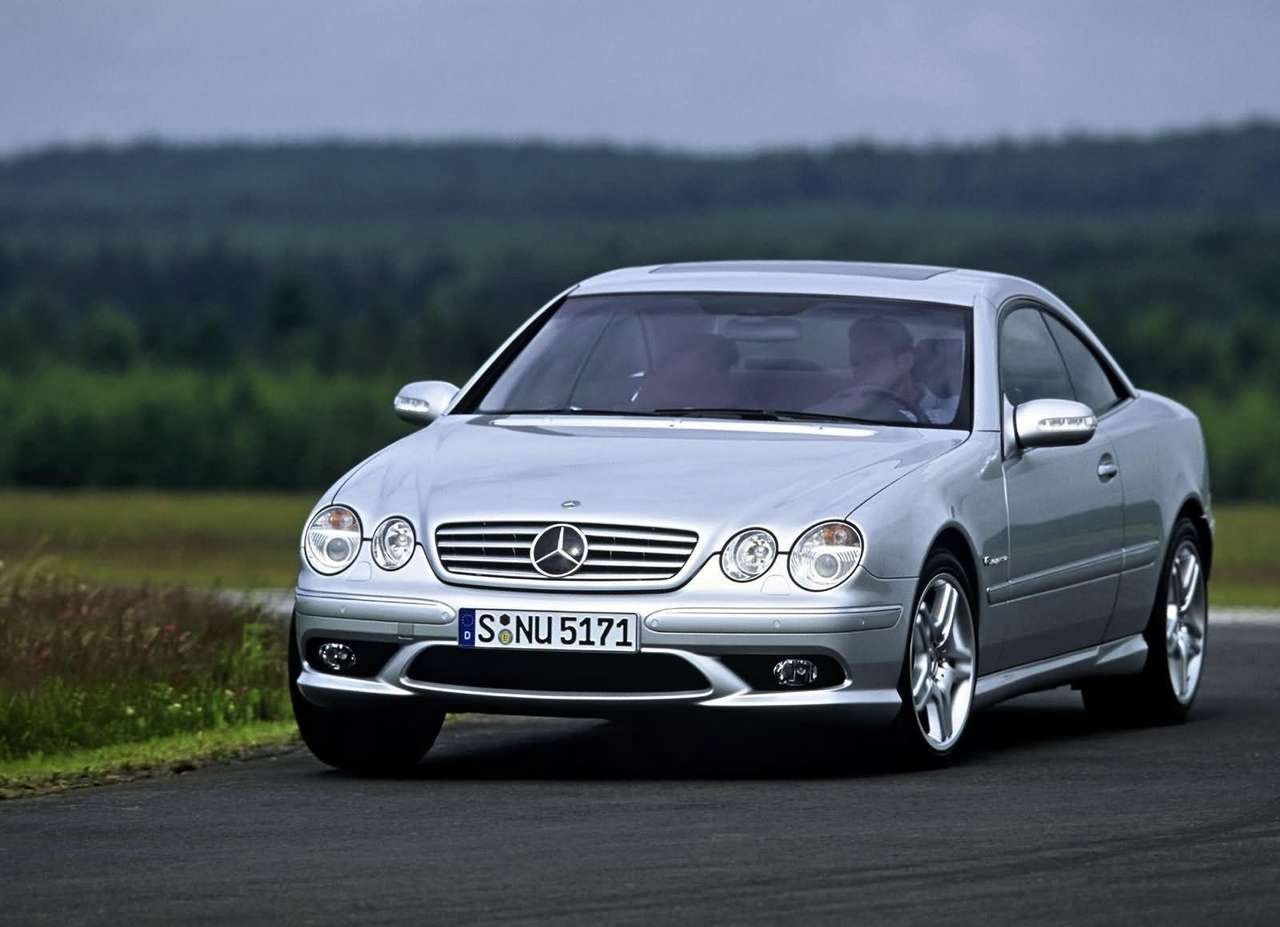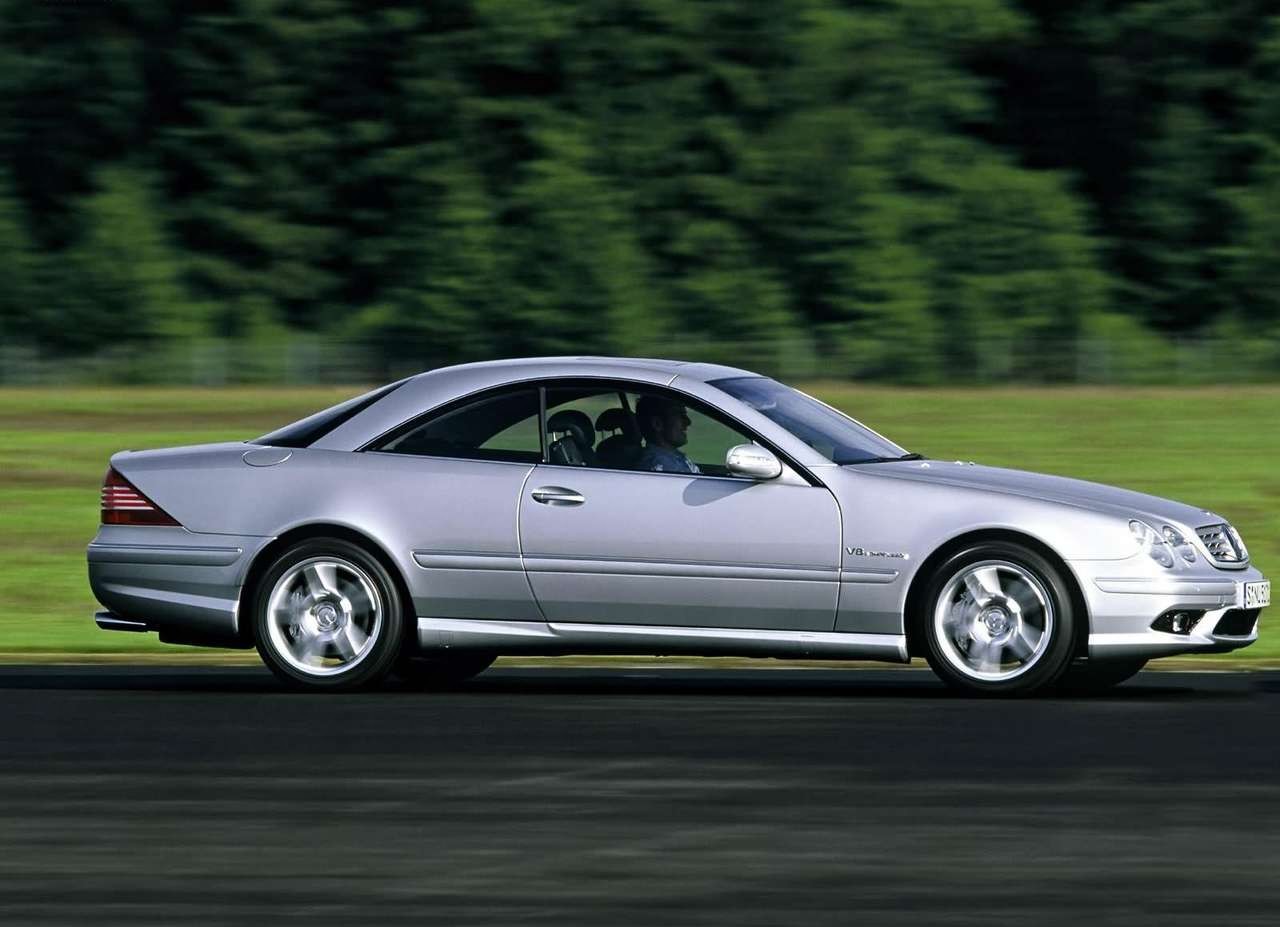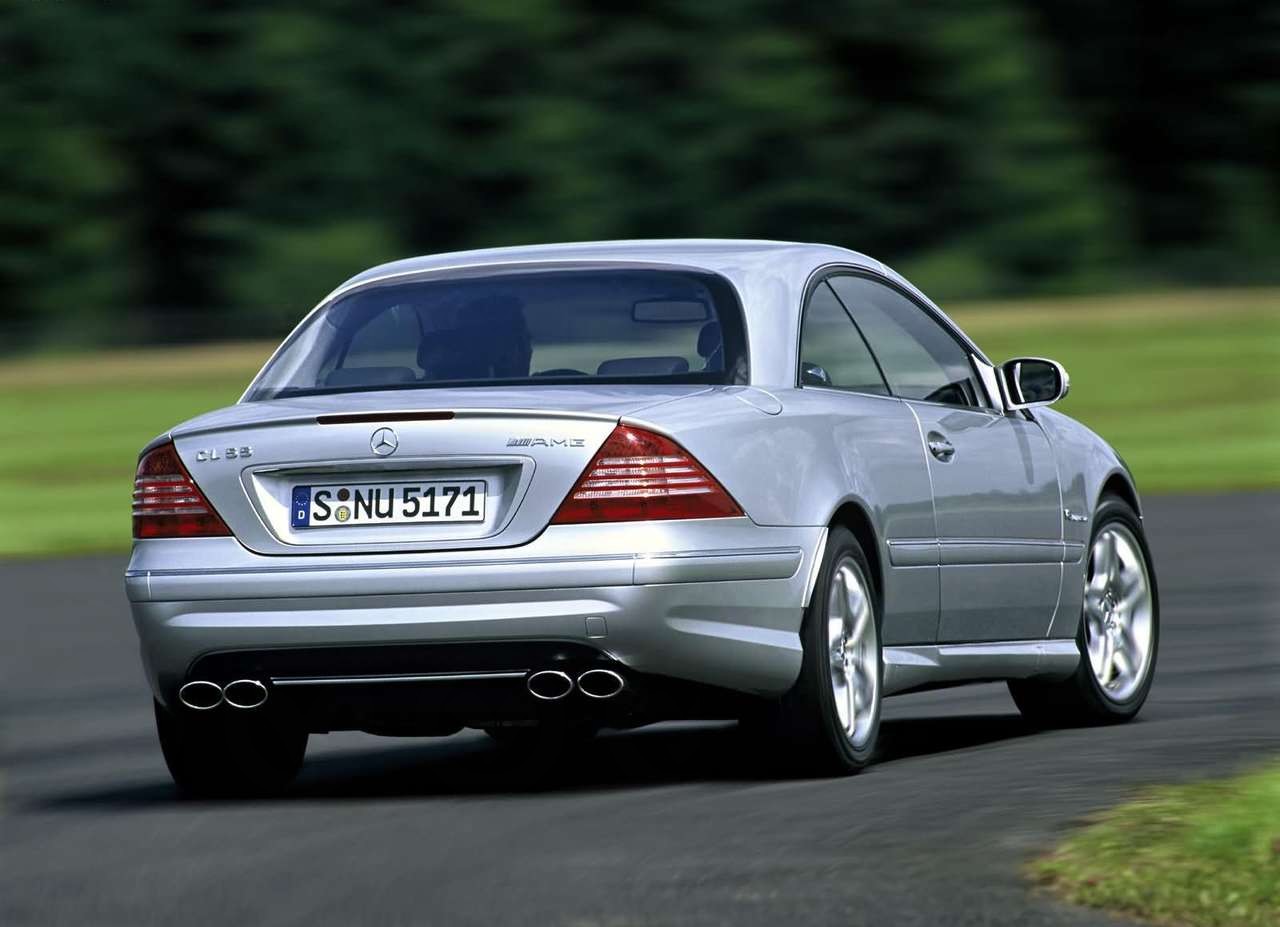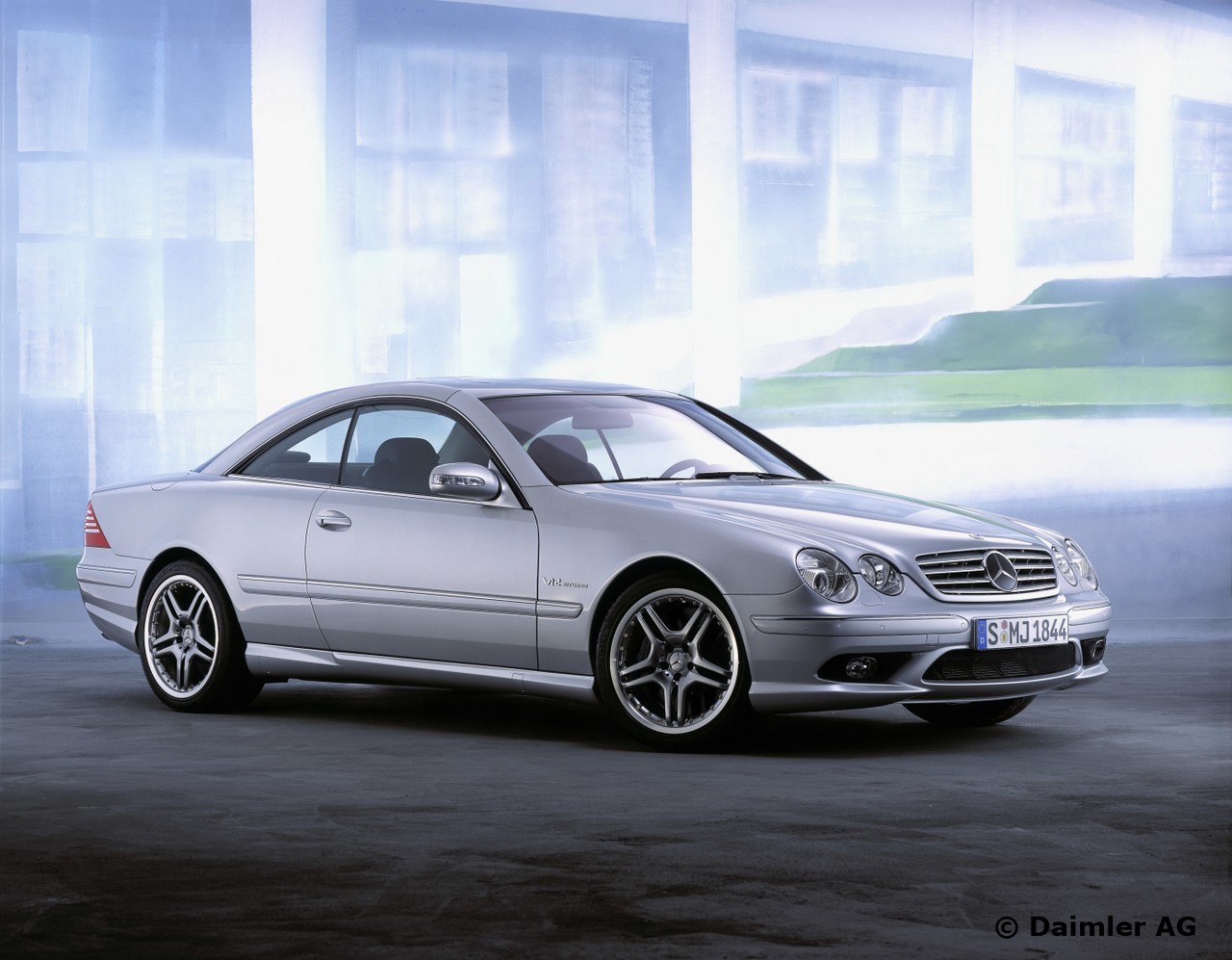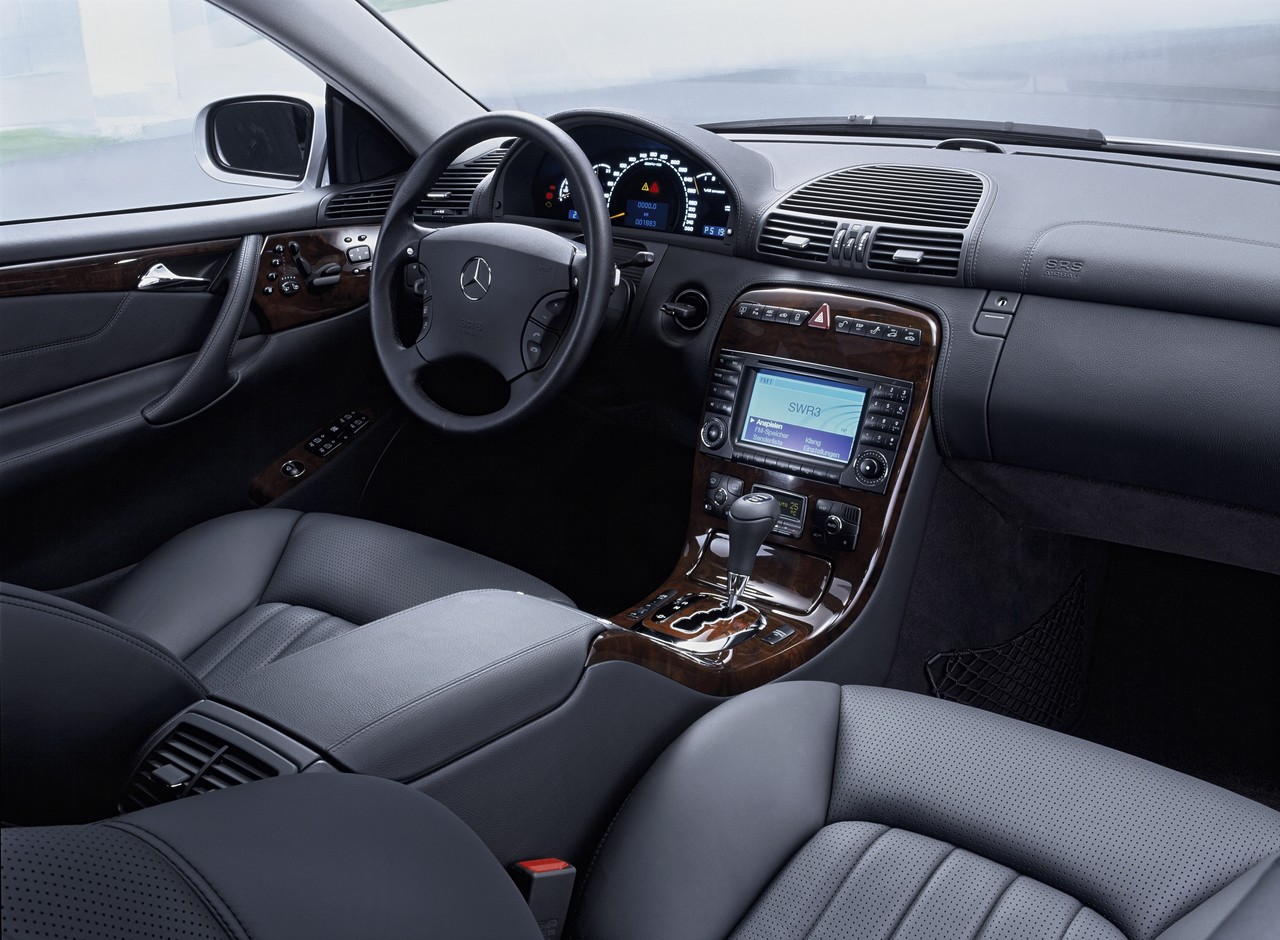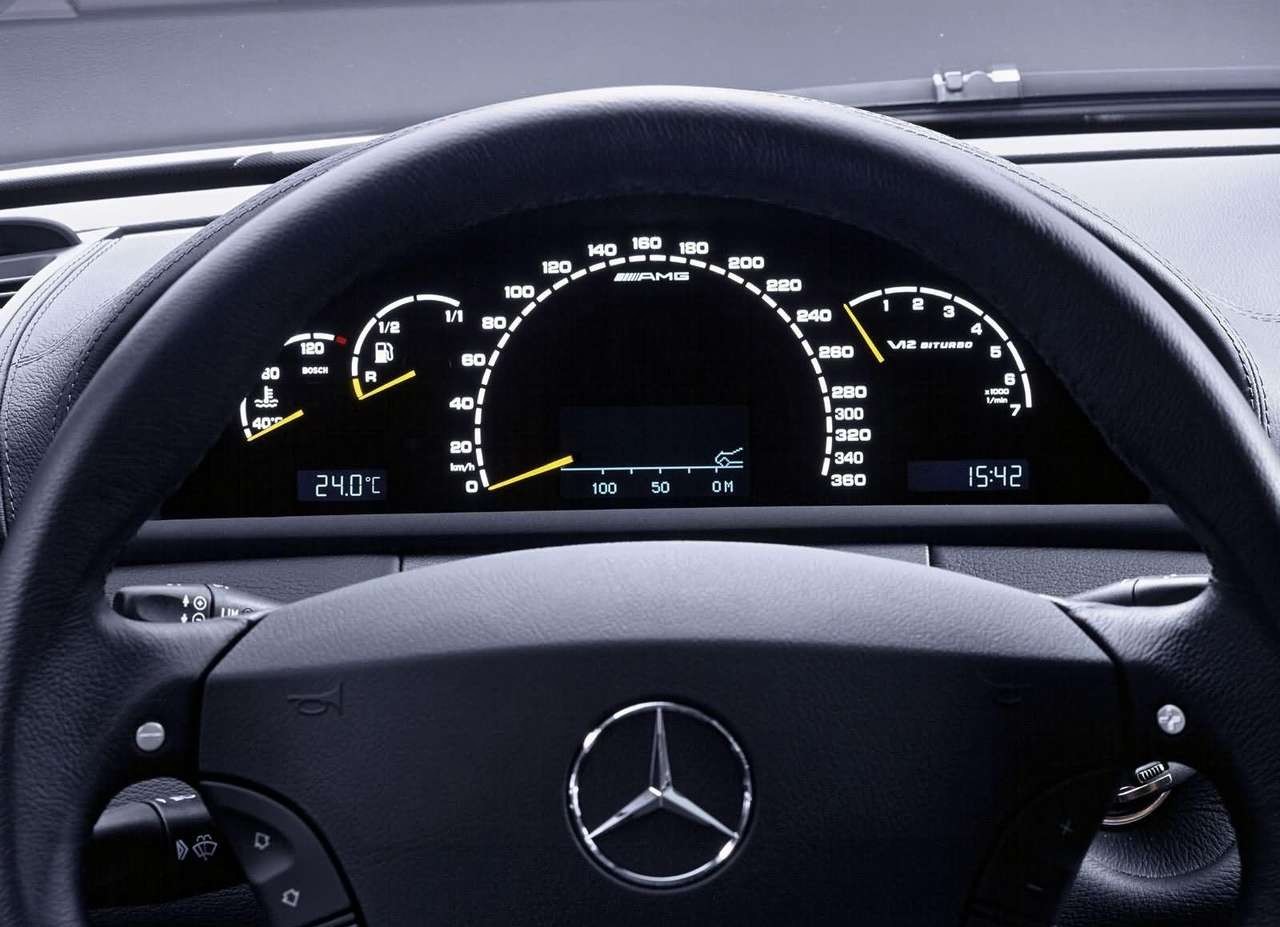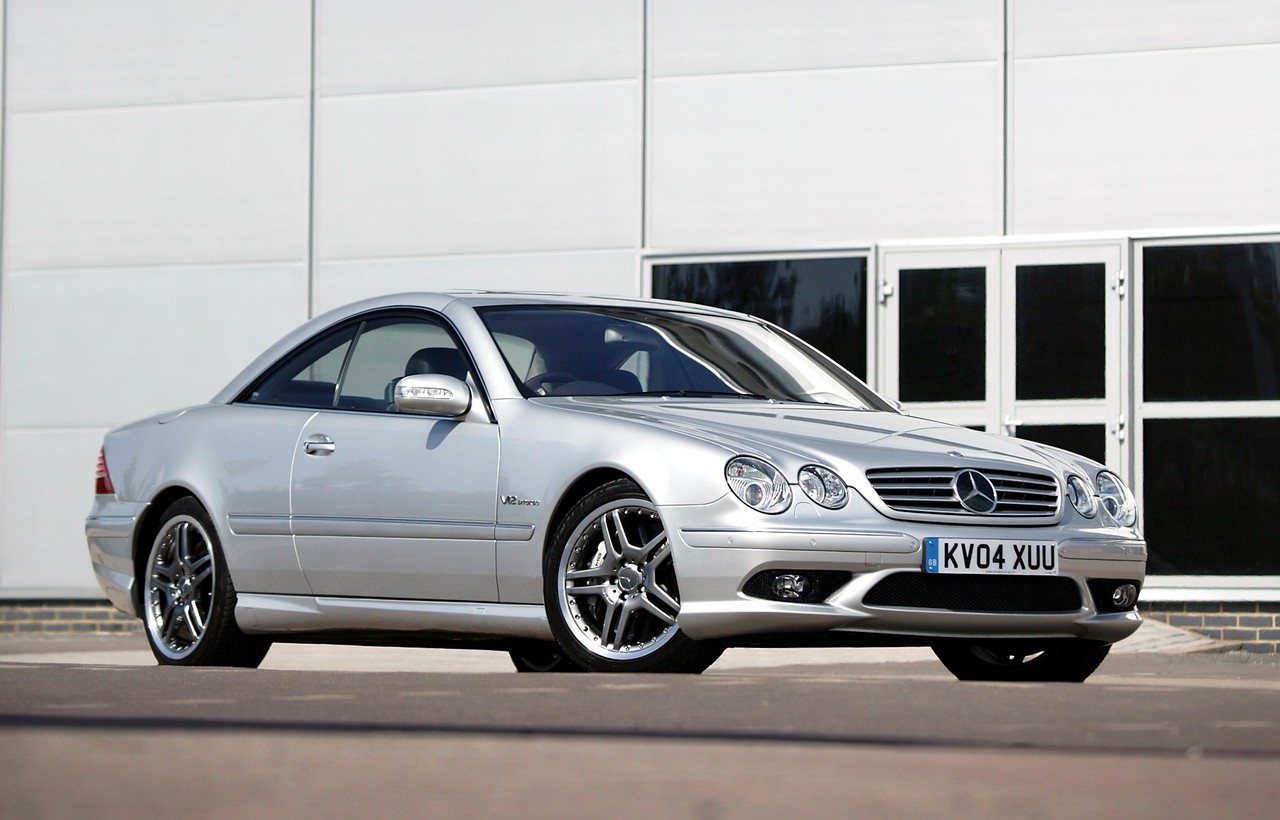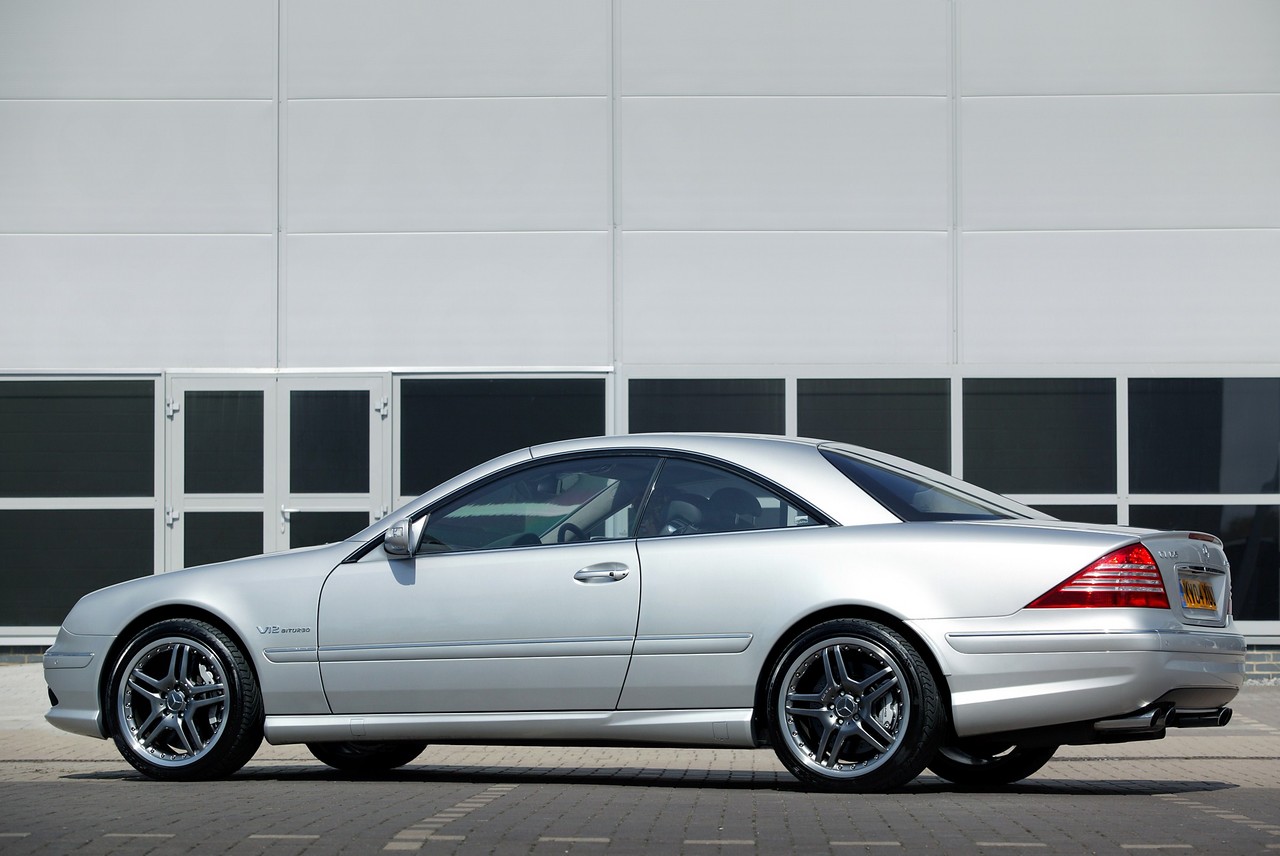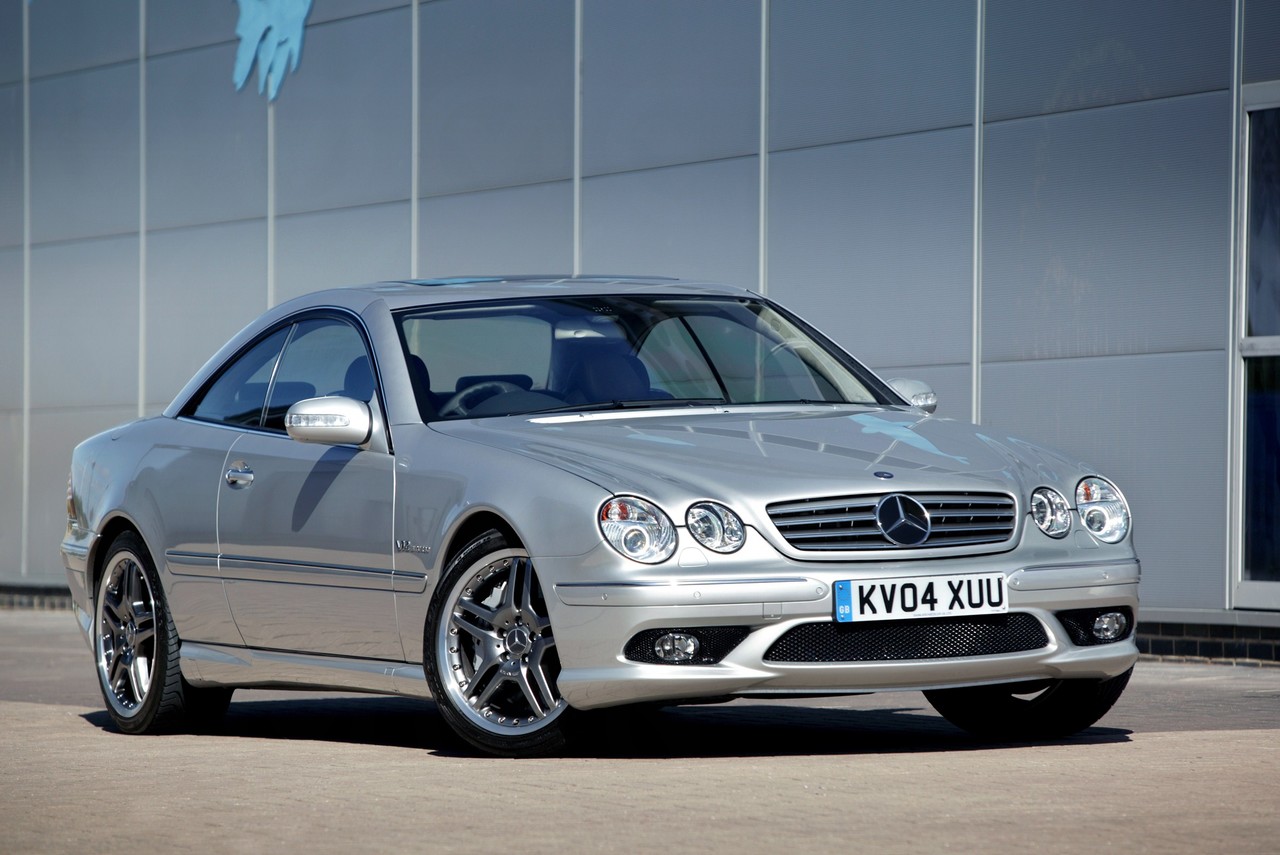
- Weight blunts agility
- High running and maintenance costs
Review: Mercedes C215.I CL 55 AMG (2001-02)
Overview
Released in Australia in July 2001, the Mercedes-Benz C216 CL 55 AMG was a grand touring coupe. Manufactured in Sindelfingen, Germany, the rear-wheel drive C215 CL 55 AMG was powered by a 5.4-litre V8 petrol engine that was mated to a five-speed automatic transmission. The C215.I CL 55 AMG was based on the C215.I CL 500 , but distinguished by its stroked engine, revised transmission ratios, upgraded brakes and AMG styling.
M113.986 V8 engine
The M113.986 V8 petrol engine had an alloy cylinder block with 97.0 mm bores and a 92.0 mm stroke for a capacity of 5439 cc, cast-in Silitec (Al-Si alloy) cylinder liners, fracture-split forged steel connecting rods, iron-coated aluminium pistons, an alloy cylinder head, a single overhead camshaft (SOHC) per cylinder bank driven by a double-roller chain, three valves per cylinder (two intake, one exhaust) actuated by roller rockers, two spark plugs per cylinder and a compression ratio of 10.5:1.
Compared to the 5.0-litre M113.960 V8 engine in the C215 CL 500 , the M113.986 engine had:
- A reconfigured crank drive;
- Forged aluminium pistons with oil-cooling via injection nozzles;
- A Twin-pipe intake system;
- Unique ‘built’ camshafts;
- A specially adapted variable intake manifold; and,
- AMG exhaust system with larger pipes and modified mufflers to reduce back-pressure (and noise).
The five-speed automatic transmission was shared with the C215 CL 500 and C215 CL 600, but its ratios were revised: 3.59 (1st), 2.19 (2nd), 1.41 (3rd), 1.00 (4th) and 0.83 (5th); the final drive ratio was 2.82.
Performance and fuel economy
The CL 55 AMG could accelerate from rest to 100 km/h in 6.0 seconds and had an electronically-limited top speed of 250 km/h. Over the combined EUDC test cycle, fuel consumption was 13.4 litres per 100 km.
| Engine | Trans. | Peak power | Peak torque | |
|---|---|---|---|---|
| CL 55 AMG | 5.4-litre petrol V8 (M113) | 5sp auto | 265 kW at 5600 rpm | 530 Nm at 3150-4500 rpm |
Dimensions and body
Like the standard C215 CL-Class , the Mercedes-Benz C215 CL 55 AMG was 4993 mm long, 1857 mm wide, 1398 mm tall and had a 2885 mm long wheelbase; kerb weight was 1865 kg. Compared to the C215 CL 500, the CL 55 AMG could be identified by its AMG body styling kit which included a modified front air dam, rear airdam and new rocker panels.
Suspension
The suspension for the Mercedes-Benz CL 55 AMG was the same as the CL 500, i.e. four-link front suspension and independent multi-link rear suspension (both with coil springs, gas-pressure shock absorbers and anti-roll bars). Similarly, the suspension included Mercedes-Benz’s ‘Active Body Control’ which used high-pressure hydraulics and a control unit to adapt suspension damping to the driving situation to reduce body movement. Furthermore, the driver could select from ‘Comfort’ and ‘Sport’ modes; according to Mercedes-Benz, ‘Sport’ mode reduced cornering roll by up to 27 per cent relative to ‘Comfort’ mode.
Steering
The CL 55 AMG had rack-and-pinion steering with speed-sensitive power assistance (Mercedes-Benz’s ‘parameter steering’).
Safety equipment
Standard safety equipment for the Mercedes-Benz CL 55 AMG included dual front airbags (with two-stage deployment), front side airbags, full-length curtain airbags (i.e. for front and rear occupants), ABS, electronic brake force distribution, brake assist, electronic stability control, traction control, and front and rear seatbelts with pre-tensioners and load limiters.
Brakes
Like the C215 CL 600 , the CL 55 AMG had 345 mm by 32 mm ventilated and perforated front brake discs and 315 mm by 22 mm ventilated rear discs.
Features: Mercedes-Benz CL 55 AMG
Like the CL 500, standard features for the Mercedes-Benz CL 55 AMG included an eleven speaker sound system with a ten-disc CD changer, COMAND (Cockpit Management and Data System) with satellite navigation, TV tuner and car phone, dual-zone climate control air conditioning, twelve-way power adjustable and heated front seats with memory settings, leather upholstery (for the instrument panel, seats, doors and armrest), cruise control, bi-xenon headlights, front and rear fog lights, front and rear parking sensors, automatic headlights, rain-sensing wipers, a multi-function steering wheel, remote central locking with proximity key (‘keyless go’), power adjustable mirrors with heating and folding functions, an automatically tilting passenger side mirror when reversing, power windows, a height and reach adjustable steering wheel, a power-operated rear blind, a power glass sunroof, memory settings (front seats, steering wheel and mirrors), a trip computer and an immobiliser.
The CL 55 AMG, however, was distinguished by its 18-inch AMG alloy wheels (8.5J front and 9.5J rear) with 245/45 R18 96Y tyres and 275/40 R18 99Y tyres, AMG instrument cluster and AMG body styling.
Review: Mercedes C215.II CL 55 AMG and 65 AMG (2002-06)
Overview
Released in Australia in October 2002, the Mercedes-Benz C215 Series II (C215.II) CL 55 was powered by a supercharged 5.4-litre V8 petrol engine; in December 2004, the range was expanded with the CL 65 AMG.
As part of the C215.II update, the AMG Speedshift transmission – with steering wheel gearshift paddles – was fitted as standard. Furthermore, the Active Body Control (ABC) system continuously measured the current gross weight of the vehicle and included this value when calculating suspension adjustments for improved dynamics.
Visually, the C215.II CL-Class could be identified by its revised front bumpers, clear-lens headlights and exit lighting for the door mirrors.
CL 55 AMG: Supercharged M113.991 V8 engine
Shared with the W220 S 55 AMG , the 5439 cc eM113.991 V8 engin had a die-cast alloy block with 97.0 mm bores and a 92.0 mm stroke, cast-in Silitec cylinder liners, fracture-split forged steel connecting rods, iron-coated aluminium pistons with oil spray cooling, an alloy cylinder head, a single overhead camshaft (SOHC) per cylinder bank driven by a double-roller chain, three valves per cylinder (two intake, one exhaust) actuated by roller rockers, two-spark plugs per cylinder, a dual-length intake manifold, a compression ratio of 9.0:1 and Bosch ME 2.8 engine management.
Unlike its naturally aspirated predecessor, the M113 engine for the C215.II CL 55 AMG engine had a Lysholm-type IHI supercharger – positioned between the cylinder banks – which provided maximum pressure of 0.8 bar and had an integrated air-water charge air cooler. The supercharger had two Teflon-coated aluminium shafts which rotated at up to 23,000 rpm, pushing 1850 kg of air per hour into the combustion chambers. To minimise fuel consumption at part throttle applications, the scroll compressor only operated at certain engine speeds and load conditions, activated by an electromagnetic coupling and a separate poly-V-belt.
Compared to its naturally aspirated counterpart, changes for the supercharged M113 engine included:
- A reinforced crankcase with stiffening ribs and side bolts;
- A precision-balanced crankshaft with modified bearings and a more resistant material;
- Unique pistons;
- Forged connecting rods;
- A revised oil supply system (including the sump, catch tray and pump) and a separate oil cooler in the right-hand wheel arch;
- Optimised cylinder heads;
- A twin-spring assembly for the valve train to increased maximum engine speed to 6100 rpm (from 5600 rpm);
- A redesigned fuel system;
- A twin-pipe exhaust system with switchover valve and 70 mm diameter tailpipes for reduced exhaust gas back-pressure; and,
- A unique engine management system.
With the introduction of the supercharged M113 engine, kerb weight for the CL 55 AMG increased from 1865 kg to 1995 kg. However, the C215.II CL 55 AMG could accelerate from rest to 100 km/h in 4.8 seconds. Over the combined EUDC test cycle, fuel consumption was 13.2 litres per 100 km.
CL 65 AMG: Biturbo M275.980 V12 engine
Shared with the V220 S 65 AMG , the 5980 cc M275.980 V12 engine had a reinforced aluminium alloy block with 82.6 mm bores and a 93.00 mm stroke, an aluminium cylinder head, twin turbochargers, manifold injection, a single overhead camshaft per cylinder bank (SOHC), three valves per cylinder (two intake and one exhaust) that were actuated by aluminium roller rocker arms, two spark plugs per cylinder, and a compression ratio of 9.0:1. Furthermore, the twin turbochargers – one per cylinder bank – had air-to-liquid intercooler and provided peak boost pressure of 1.52 bar (22.1 psi).
Compared to the standard 6.0-litre biturbo V12, changes for the AMG version included:
- Higher-strength material for the crankshaft;
- The forged pistons were made from a temperature and pressure resistant material and had an upgraded oil-spray cooling system with a separate individual nozzle per piston. The size of the piston pins was also increased;
- The main and connecting rod bearings were made from higher-specification material;
- The combustion chambers in the cylinder heads were optimised;
- The camshafts had increased stroke on the intake side and longer opening times;
- The oil pump was modified and a larger oil cooler used to ensure lubrication under extreme conditions;
- The housings of the compressor and turbine, the turbine and the compressor wheels were enlarged;
- Maximum charge pressure was increased to 1.5 bar;
- Larger injection valve openings increased fuel throughput;
- New intercooler design which featured a 70 per cent larger front-mounted low-radiator;
- The system pressure of the computer-controlled fuel system was increased to 3.8 bar; and,
- A new engine management system was used, which included new wastegate valve actuation control for both turbochargers.
While the engine could produce peak torque of 1200 Nm, it was electronically-limited to 1000 Nm to protect the transmission. Nonetheless, the CL 65 AMG required modified drive shafts and larger wheel carriers; combined with the engine, these changes resulted in the CL 65 AMG being 160 kg heavier, with a kerb weight of 2155 kg. For the suspension, the CL 65 AMG had unique, AMG-specific struts and stiffer shock absorbers.
The C216.II CL 65 AMG could accelerate from rest to 100 km/h in 4.4 seconds. Over the combined EUDC test cycle, fuel consumption was 14.9 litres per 100 km.
| Engine | Years | Trans. | Peak power | Peak torque | |
|---|---|---|---|---|---|
| CL 55 AMG | 5.4-litre s/charged petrol V8 (M113) | 2002-06 | 5sp auto | 368 kW at 6100 rpm | 700 Nm at 2750-4000 rpm |
| CL 65 AMG | 6.0-litre bi-turbo petrol V12 (M275) | 2004-06 | 5sp auto | 450 kW at 4800 rpm | 1000 Nm at 2000-4000 rpm |
AMG Speedshift transmission
The Mercedes-Benz CL 55 AMG and CL 65 AMG were fitted with the five-speed ‘AMG Speedshift’ automatic transmission. In the manual ‘M’ mode, the driver could use steering wheel gearshift buttons to perform gearshifts – in this mode, the transmission would not automatically kickdown in response to throttle inputs, nor would it upshift a the rev limit. Other features of the AMG Speedshift transmission included:
- A torque converter lock-up function above first gear to reduce torque converter slip and increase fuel efficiency;
- It would stay in the current gear if a certain level of lateral acceleration was present (intended to delay or prevent gearshifts when cornering); and,
- An optimum gear function – selected by moving the ‘Touchshift’ lever to the left – which would cause the transmission to select the gear for maximum acceleration (depending on current speed and engine management data).
Gear ratios for the C215.II CL 55 AMG were 3.60 (1st), 2.19 (2nd), 1.41 (3rd), 1.00 (4th) and 0.83 (5th), while the final drive ratio was 2.65. For the CL 65 AMG, the only change was to the ratio of the first gear (3.59).
For the CL 65 AMG, changes for the AMG Speedshift transmission included:
- New converter discs with a metal coating;
- A larger torque-converter lock-up clutch; and,
- Modified shift and torque converter lock-up logic.
Safety equipment
Compared to its C215.I predecessor, standard safety equipment for the Mercedes-Benz C215.II CL-Class was largely unchanged. However, the introduction of two front-mounted satellite sensors enabled earlier detection of the severity of an accident, enabling earlier deployment of the seatbelt tensioners and the appropriate inflation of the two-stage aiding front airbags. There was also a weight classification feature for the front passenger to assist airbag deployment.
Brakes: CL 55 AMG
The C215.II CL 55 AMG had 360 mm by 32 mm front brake discs and 330 mm by 22 mm rear discs; both front and rear discs were ventilated and perforated.
Brakes: CL 65 AMG
The CL 65 AMG had 390 mm by 36 mm composite front brake discs (grey cast iron discs and aluminium brake-disc bowls) with eight-piston callipers; the rear discs were 348 mm by 26 mm and had four-piston callipers. Both front and rear discs were internally ventilated and perforated.
Features: Mercedes-Benz CL 55 AMG
The C215.II CL 55 AMG was fitted 18-inch AMG alloy wheels (8.5J front and 9.0J rear) with 245/45 R18 front and 265/40 R18 rear tyres, while the COMAND system had a larger 6.5-inch 16:9 colour display.
From September 2003, the CL-Class was fitted with the DVD-based COMAND APS system.
Features: Mercedes-Benz CL 65 AMG
Compared to the CL 55 AMG, the CL 65 AMG was distinguished by its 19-inch AMG double spoke wheels with 245/40 ZR 19 front and 275/35 ZR 19 rear tyres, multi-contour AMG sports seats with AMG-specific seat graphics and perforations, and three-tone ‘Exclusive Nappa’ leather upholstery.
Brochure
Related links
